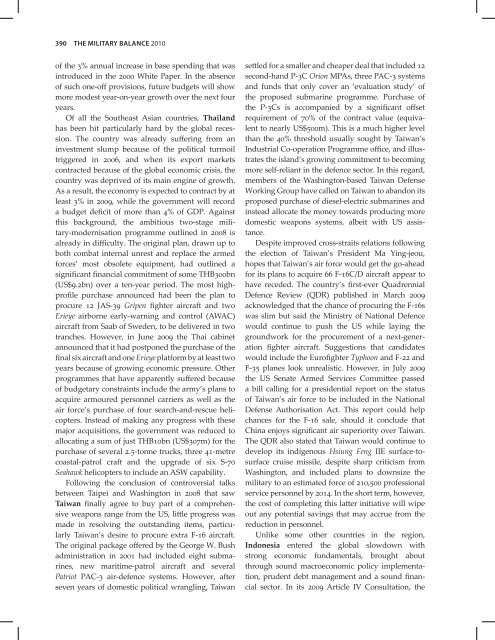Create successful ePaper yourself
Turn your PDF publications into a flip-book with our unique Google optimized e-Paper software.
390 THE MILITARY BALANCE 2010<br />
of the �% annual increase in base spending that was<br />
introduced in the ���� White Paper. In the absence<br />
of such one-off provisions, future budgets will show<br />
more modest year-on-year growth over the next four<br />
years.<br />
Of all the Southeast Asian countries, Thailand<br />
has been hit particularly hard by the global recession.<br />
The country was already suffering from an<br />
investment slump because of the political turmoil<br />
triggered in ����, and when its export markets<br />
contracted because of the global economic crisis, the<br />
country was deprived of its main engine of growth.<br />
As a result, the economy is expected to contract by at<br />
least �% in ����, while the government will record<br />
a budget deficit of more than �% of GDP. Against<br />
this background, the ambitious two-stage military-modernisation<br />
programme outlined in ���� is<br />
already in difficulty. The original plan, drawn up to<br />
both combat internal unrest and replace the armed<br />
forces’ most obsolete equipment, had outlined a<br />
significant financial commitment of some THB���bn<br />
(US$�.�bn) over a ten-year period. The most highprofile<br />
purchase announced had been the plan to<br />
procure �� JAS-�� Gripen fighter aircraft and two<br />
Erieye airborne early-warning and control (AWAC)<br />
aircraft from Saab of Sweden, to be delivered in two<br />
tranches. However, in June ���� the Thai cabinet<br />
announced that it had postponed the purchase of the<br />
final six aircraft and one Erieye platform by at least two<br />
years because of growing economic pressure. Other<br />
programmes that have apparently suffered because<br />
of budgetary constraints include the army’s plans to<br />
acquire armoured personnel carriers as well as the<br />
air force’s purchase of four search-and-rescue helicopters.<br />
Instead of making any progress with these<br />
major acquisitions, the government was reduced to<br />
allocating a sum of just THB��bn (US$���m) for the<br />
purchase of several �.�-tonne trucks, three ��-metre<br />
coastal-patrol craft and the upgrade of six S-��<br />
Seahawk helicopters to include an ASW capability.<br />
Following the conclusion of controversial talks<br />
between Taipei and Washington in ���� that saw<br />
Taiwan finally agree to buy part of a comprehensive<br />
weapons range from the US, li�le progress was<br />
made in resolving the outstanding items, particularly<br />
Taiwan’s desire to procure extra F-�� aircraft.<br />
The original package offered by the George W. Bush<br />
administration in ���� had included eight submarines,<br />
new maritime-patrol aircraft and several<br />
Patriot PAC-� air-defence systems. However, after<br />
seven years of domestic political wrangling, Taiwan<br />
se�led for a smaller and cheaper deal that included ��<br />
second-hand P-�C Orion MPAs, three PAC-� systems<br />
and funds that only cover an ‘evaluation study’ of<br />
the proposed submarine programme. Purchase of<br />
the P-�Cs is accompanied by a significant offset<br />
requirement of ��% of the contract value (equivalent<br />
to nearly US$���m). This is a much higher level<br />
than the ��% threshold usually sought by Taiwan’s<br />
Industrial Co-operation Programme office, and illustrates<br />
the island’s growing commitment to becoming<br />
more self-reliant in the defence sector. In this regard,<br />
members of the Washington-based Taiwan Defense<br />
Working Group have called on Taiwan to abandon its<br />
proposed purchase of diesel-electric submarines and<br />
instead allocate the money towards producing more<br />
domestic weapons systems, albeit with US assistance.<br />
Despite improved cross-straits relations following<br />
the election of Taiwan’s President Ma Ying-jeou,<br />
hopes that Taiwan’s air force would get the go-ahead<br />
for its plans to acquire �� F-��C/D aircraft appear to<br />
have receded. The country’s first-ever Quadrennial<br />
Defence Review (QDR) published in March ����<br />
acknowledged that the chance of procuring the F-��s<br />
was slim but said the Ministry of National Defence<br />
would continue to push the US while laying the<br />
groundwork for the procurement of a next-generation<br />
fighter aircraft. Suggestions that candidates<br />
would include the Eurofighter Typhoon and F-�� and<br />
F-�� planes look unrealistic. However, in July ����<br />
the US Senate Armed Services Commi�ee passed<br />
a bill calling for a presidential report on the status<br />
of Taiwan’s air force to be included in the National<br />
Defense Authorisation Act. This report could help<br />
chances for the F-�� sale, should it conclude that<br />
China enjoys significant air superiority over Taiwan.<br />
The QDR also stated that Taiwan would continue to<br />
develop its indigenous Hsiung Feng IIE surface-tosurface<br />
cruise missile, despite sharp criticism from<br />
Washington, and included plans to downsize the<br />
military to an estimated force of ���,��� professional<br />
service personnel by ����. In the short term, however,<br />
the cost of completing this la�er initiative will wipe<br />
out any potential savings that may accrue from the<br />
reduction in personnel.<br />
Unlike some other countries in the region,<br />
Indonesia entered the global slowdown with<br />
strong economic fundamentals, brought about<br />
through sound macroeconomic policy implementation,<br />
prudent debt management and a sound financial<br />
sector. In its ���� Article IV Consultation, the


